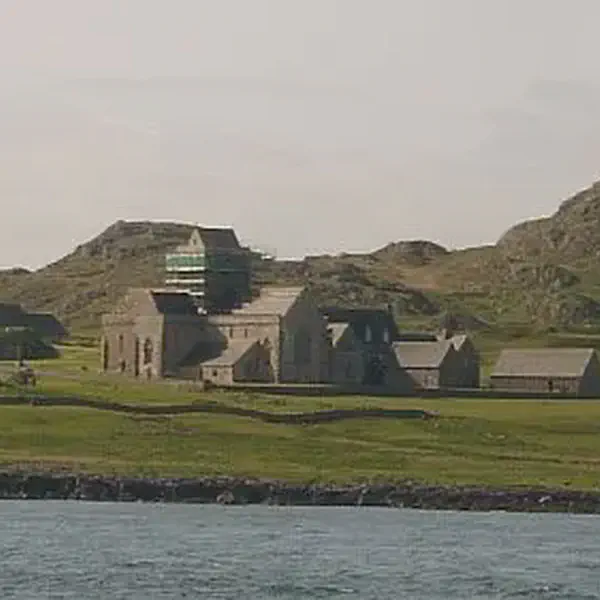
Iona Raided for Second Time by Norsemen
January 19, 825
Blathmac, a monk on the island of Iona, lived during a time when Viking raids on monastic communities were common. Iona, being a renowned center of Christian learning and the burial site of St. Columba, was a prime target for these raids.
During the Viking raid on Iona in 825, the Norsemen demanded to know the location of St. Columba’s relics which was buried by the monks. The vikings slaughtered all the monks after mass, but kept Blathmac alive. Steadfast in his faith and duty to protect the sacred relics, Blathmac refused to reveal their location. Consequently, he was martyred by the raiders.
Columba’s Relics
St. Columba, also known as Colum Cille, was the founder of the monastery on Iona and a revered saint. After his death in 597, his relics, or physical remains, were considered extremely holy and valuable, not just spiritually but also materially.
The island of Iona, located off the west coast of Scotland, was subjected to Viking raids during the early medieval period. These raids were a part of the broader Viking expansion into the British Isles and other European territories during the Viking Age, which roughly spanned from the late 8th century to the early 11th century.
It’s not uncommon for areas like Iona to have experienced multiple Viking raids. The Vikings, or Norsemen, were seafaring warriors who targeted monasteries and other settlements for their wealth, which often included valuable religious relics and precious metals. The first Viking raid on Iona occurred in the late 8th century, and subsequent attacks followed in the centuries that followed.
These raids had a profound impact on the monastic communities of Iona and other areas, resulting in the loss of valuable possessions and the disruption of religious and cultural life. The Viking raids on Iona are a part of the broader historical narrative of the Viking Age and their influence on the regions they targeted.
Iona
Iona holds a significant place in the history of Christianity in the British Isles, particularly during the early medieval period. Founded by St. Columba in AD 563, it became one of the most renowned centers of religious learning and art in the region. Here are some key aspects of Iona’s history and legacy:
Foundation by St. Columba
St. Columba, also known as Colum Cille, was an Irish monk and missionary. He founded the monastery on Iona after leaving Ireland, and it became the center of his evangelical mission in Scotland. The island was given to him by King Conall of Dál Riata, an Irish kingdom that included parts of western Scotland.
Cultural and Religious Significance
Iona quickly became a significant religious and cultural center in the Celtic Christian world. It was a hub for the spread of Christianity among the Picts and Scots and played a crucial role in the religious and cultural life of the region.
Center of Learning and Art
The monastery on Iona was known for its scholarly activities and the production of high-quality manuscripts. The most famous of these is the Book of Kells, believed to have been partially created at Iona before being completed at Kells in Ireland. The Book of Kells is renowned for its exquisite illuminations and is considered one of the greatest masterpieces of Insular art.
Role in the Spread of Christianity
Monks from Iona, following in Columba’s footsteps, were instrumental in evangelizing parts of northern Britain. They established daughter houses and spread the Christian faith across Scotland and into northern England.
Viking Raids and Decline
Iona was subjected to several Viking raids beginning in the late 8th century. These raids were devastating to the community, leading to loss of life, destruction of property, and the decline of the monastery’s influence.
Historical Legacy
Despite the decline following the Viking raids, Iona remains an important symbol in Christian history. It is seen as a symbol of Scottish Christianity and its spread throughout the British Isles.
Modern Iona
Today, Iona is a place of pilgrimage and spiritual retreat. The Iona Community, an ecumenical Christian community founded in the 20th century, is based there and continues the island’s tradition of spiritual hospitality.
The founding of the monastery on Iona by St. Columba represents a pivotal moment in the history of Christianity in the British Isles, embodying the spread of the faith, the flourishing of religious art and learning, and the enduring cultural connections between Ireland, Scotland, and beyond.